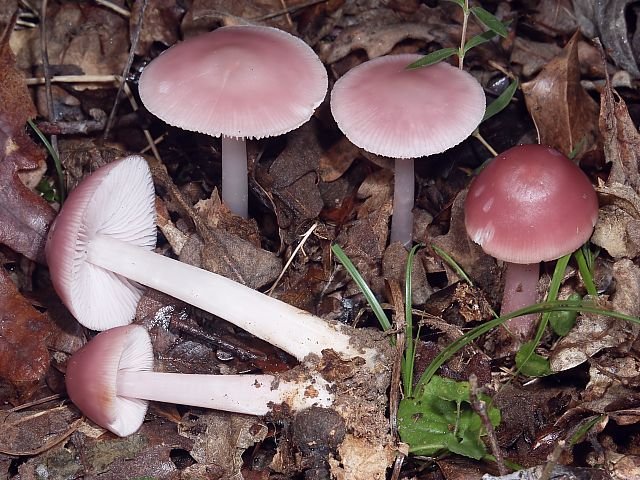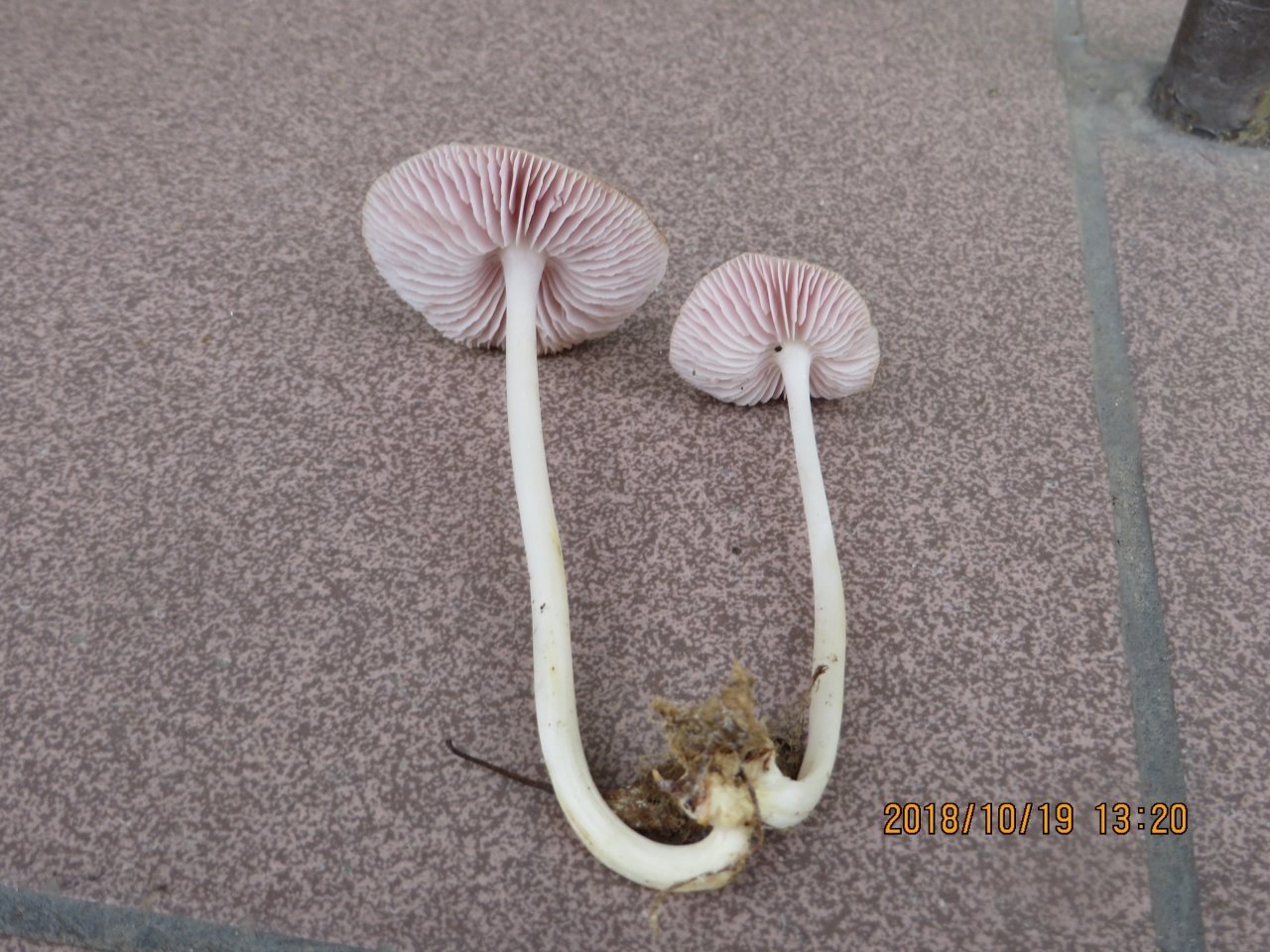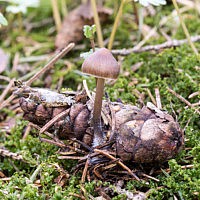Mycena pura
Synonyms:
- Agaricus purus
- Gymnopus purus
External description
Hat: at first it has the shape of a hemisphere, then it becomes wide-conical or blunt-bell-shaped to convex, outstretched. Ripe mushrooms sometimes have a raised edge. The surface of the cap is slightly slimy, pale gray-brown in color. In the center of a darker shade, the edges of the cap are striped, translucent, grooved. The diameter of the cap is 2-4cm.
Plates: rather rare, indulgent. Can be narrow adherent or wide adherent. Smooth or slightly wrinkled, with veins and transverse bridges at the base of the cap. White or grayish white in color. Along the edges of a lighter shade.
Spore powder: white.
Micromorphology: Spores are elongated, cylindrical, clavate.
Leg: Hollow inside, fragile, cylindrical. Leg length up to 9cm. thickness - up to 0.3 cm. The surface of the leg is smooth. The upper part is covered with a matte coating. A fresh mushroom secretes a large amount of a watery liquid at the fracture of the stem. At the base, the pedicle is covered with long, coarse, whitish hairs. In dried specimens, the stem is shiny.
Flesh: thin, watery, grayish in color. The smell of the mushroom is a bit sparse, sometimes pronounced.
Spreading
Mycena pure (Mycena pura) is found on the litter of dead hardwood, grows in small groups. Also found on mossy trunks in deciduous forest. Sometimes, as an exception, it can settle on spruce wood. A common species in Europe, North America and Southwest Asia. Fruiting from early spring to early summer. Occasionally found in autumn.
Edibility
It is not eaten because of the unpleasant smell, but in some sources, the mushroom is classified as poisonous.
Contains Muscarine. Considered mildly hallucinogenic.
Remarks
This species is included in the Red Lists in some European countries: France, Norway, Latvia, Denmark. In the Red Book of the Russian Federation, Mycena pura is not listed. Mycena (lat.Mycena) is a genus of mushrooms of the Mycenaceae family.
Mushroom photo Mycena clean from questions in recognition:
Features of the classification
The genus Mycena includes approximately 200 species. According to the researchers, the main classification criteria are the size of the specimen and the level of concentration of the poison in it. Some mycene contain alkaloids, which can provoke vomiting, diarrhea, visual impairment, increased emotionality.
The most popular representatives of the genus
The following types are of the greatest interest to scientists:
- Mycena pura (pure). This variety is found in deciduous forests, among moss, rarely on spruce wood. Can grow in groups or singly. Belongs to the category of weakly poisonous and weakly hallucinogenic eukaryotes, has an unpleasant odor. In France, Norway, Denmark and Latvia, the species is listed in the Red Book.
- Mycena viscosa (sticky). It grows mainly in spruce coniferous forests, on coniferous or deciduous litter, stumps, near tree roots. The fruiting period is from May to September. Grows in small colonies, found in the European part of Russia, Primorye, some European countries. An immature mushroom has a grayish brown tint. A mature eukaryote has a lemon-yellow leg and a cap with small red-brown spots. This species does not contain toxic components, but is classified as inedible due to a putrid odor.
- Mycena rosea (pink). Eukaryotes are found in deciduous and mixed forests, among fallen leaves. The fruiting body of the fungus is pink, which in the central part acquires a fawn hue. Can grow singly or in small groups. This variety contains the poisonous substance muscarine, the use of which in large doses can be fatal.
- Mycena cyanorrhiza (blue-footed).Grows in coniferous and mixed forests, on bark, rotten wood. Fruiting from June to September. It belongs to rare species. Contains the poisonous element psilocybin.
- Mycena vulgaris (common). It is found in mixed, coniferous forests, in the middle of the litter of needles. Inhabits European territory, North America, Asian countries. This species is not poisonous. However, in some cases, it is considered inedible due to its small size, as this makes processing difficult after collection.
- Mycena Chlorophos (chlorophos). Prefers a tropical climate, moist or humus soil. Can be found in Australia, South America, Asia. The species has a gray tint, which changes to pale green in the dark.
mycene blue-footed - is a rare representative of the genus mycena
Description of the inedible mushroom
Inedible eukaryotes of the genus Mycena differ in appearance. For example, the mushroom Mycena pink is characterized by a smooth surface of the cap, the diameter of which is 3-6 cm. In immature eukaryotes, the cap is bell-shaped with a tubercle in the center. When ripe, it becomes more convex or outstretched. The leg has the shape of a cylinder, its length does not exceed 10 cm. The pulp of this species is distinguished by its white color, a pronounced radish smell.
Mycenae is pure by description and resembles a pink eukaryote. However, the surface of its cap is slightly slimy, has a gray-brown tint with a darker center. The leg is cylindrical with a smooth surface, its length is up to 9 cm. The pulp is characterized by wateriness, a gray tint, and the presence of a rare odor.
mycena milk belongs to the edible representatives of the genus
Edible mushrooms
Edible eukaryotes include Mycena galopus (milk). The hat of this type is bell-shaped or cone-shaped, 1-2.5 cm in diameter, the color is gray or gray-brown. The leg reaches a height of 5-9 cm, has a cylindrical shape. The pulp has a mild taste, the smell may be weak, rare or absent. Found in all types of forests. Some experts do not recommend eating this species. When harvesting, it can easily be confused with poisonous mycens.
The most popular representatives of the genus
From a gastronomic point of view, absolutely all mycenae are uninteresting. Some belong to the group of poisonous eukarites, others are conditionally edible. Doctors and scientists advise not to risk their own health and to eat only proven, high-quality and processed mushrooms.
But some members of the family still interested the scientific community.
3 types of mycene attract particular attention of mycologists: pure, pink and sticky
Net
This unique mushroom is found almost all over the world. Mycologists argue that pure mycene can grow both in Greenland and in Africa, without experiencing, at the same time, any difficulties in development. For a long time, the mushroom was classified as edible. After frequent confirmed cases of poisoning, scientists revised their minds and named pure mycene a weakly poisonous eukaryote. Moreover, psychotropic compounds were found in the composition of the fungus, which worsened the already precarious position of the mycene. To the category of "weakly poisonous" was added "weakly hallucinogenic".
How to recognize a mushroom?
- The cap develops in the shape of a bell; as it grows, it becomes noticeably convex and voluminous. The average diameter is 2 to 4 centimeters. There are characteristic notches along the edge of the cap.
- The color palette of the hat is as diverse as possible. It can be purple, blue, gray and pale pink.
- The plates on the hymenophore are painted in lavender, sometimes the shade duplicates the cap. The plates are massive and rare.
- The fracture of the pulp is characterized by a light lilac color.
- Experts say that the taste of the mushroom is very similar to the radish. But it is strictly forbidden to eat the product. At best, this will lead to intestinal upset, at worst - to hospitalization.
- The eukaryote stem is thin, smooth, and resembles a cylinder in shape.Inside, part of the fruiting body is hollow, colored in the color of the cap.
- Mycena clean grows on fallen needles and leaves. Fruiting from June to September.
Pink
The mushroom attracts attention with its neat pink cap. As it grows and develops, the bright color becomes paler and gradually turns to gray
Bright pink hats, in the midst of brownish-dirty sheets and soil, immediately attract the attention of humans and predators. Eukaryote grows in forests, among old fallen leaves. Most often, the pink mushroom chooses forests of mixed and deciduous types.
The mycene contains the poisonous component muscarin, which determines the specificity of the effect of the fungus on the body. It is strictly forbidden to eat such a product, in especially severe cases it leads to death.
How to recognize a mushroom?
- The characteristic pink shade of the cap.
- It develops both singly and in whole species groups.
- Grows in the southern regions. Fruiting from May to November.
- Most often it develops under oak and beech.
- The pulp has a neutral odor and is colored white at the break.
- The cap is smooth, without characteristic notches or bulges.
- The pink mushroom cap is never more than 3 centimeters in diameter. The center of the cap is decorated with a small tubercle, and the edges can be wrapped in any direction.
- Mycene plates are colored in a light pink pastel shade, large, located close to each other.
- A faint radish smell emanates from the eukaryote.
- The leg is smooth on the outside, hollow on the inside, painted in a white shade.
Sticky (sticky)
Primarily, the cap develops in the form of a bell. As it matures, it settles and increases in breadth. A small smooth tubercle forms in the central part of the cap. Stripes branch radially around it. The edge of the cap is covered with uneven scars.
How to recognize a mushroom?
- The diameter of the cap is about 2-3 centimeters.
- The surface is smooth, glossy, covered with a thin mucous layer.
- Immature eukaryotes are grayish brown. Mature mycenae acquire a yellow tint and small red spots.
- Fungal plates are thin, narrow, often grow together with each other.
- The leg is high, stiff and rounded. Its height is about 6 centimeters, and its diameter is 0.2 centimeters. The surface of the leg is smooth, at the base it is overgrown with a specific fluff. The color of the leg can change its color. When pressed, it becomes reddish, in a calm state it is colored with a bright lemon shade.
- The flesh is brittle, gray and very thin. A faint putrid scent emanates from it.
- Grows in spruce and coniferous forests. It prefers to grow near massive stumps, next to tree roots, on a litter of needles and leaves. Fruiting from May to September.
WORLD OF PLANTS. Exotic mushrooms
Double dictophora is an edible exotic mushroom that is very rare on the territory of Russia, in connection with which it was listed in the Red Book. The people call her a lady under a veil or a netnose. Grows from July to September
What mushrooms are there? There are such unusual representatives that will amaze even seasoned mushroom pickers.
In a young state (before losing the whiteness of the pulp), it is a completely edible and tasty mushroom!
Most of mycenes are poisonous. This is mycena - hairy.
A bright representative of the Negniychnik clan.
Irons are most often poisonous ...
Rhodotus palmatus (Rhodotus palmatus).
Can be found on stumps and trunks of dead trees throughout the northern hemisphere. Depending on the lighting, it changes the color intensity
Veselka knows how to be beautiful!
Mushrooms of this family can amaze with their appearance!
The purple webcap is a completely edible mushroom of an unusual color.
Found in many regions of the former USSR
Common nutcracker is beautiful and unusual - it is found everywhere.
In our country it is considered inedible, but in tropical countries people are happy to consume it for food!
Hairy tube - Panus Fasciatus.
Found in Australia, they adapt well to lack of moisture.
Another striking representative of the Veselkov family is the Red Lattice.
Inedible, but very unusual!
Orange porous mushroom - Favolaschia Calocera.
Its unusual appearance pleases the inhabitants of Madagascar, Australia, New Zealand, Italy, China, Iceland and others.
A bright representative of the genus Goblets of the family of Nesting mushrooms.
The many faces of Gasteromycetes include many unusual species.
Unrecognized delicacy - White dung.
Before dyeing the plates, it is completely edible (but it must be consumed within 1-2 hours after picking the mushrooms!) And is especially appreciated by gourmets abroad.
The starlet mushroom looks like an asterisk!
In this perspective, the edible morel looks great!
The crepidot mushroom is white, yellowish, brownish and of such a bright color:
Cyptotrama aspratum tropical mushroom (Golden Tufts)
And even though most of these unusual mushrooms are not good for food, they definitely decorate the forest with themselves!
Mushroom Hydnellum Peka or Rotten Tooth
The inedible mushroom Hydnellum Peka has a very unusual appearance. At first glance, it seems that drops of blood appear on its surface. Hydnellum Peka can be found in Europe, North America, Iran and Korea.
The first descriptions of this unusual mushroom appeared in 1913. It is little studied, so someone considers it poisonous, while others recognize it as simply inedible. In the middle of the 20th century, it turned out that Hydnellum Peka contains substances that prevent the formation of blood clots. With the help of an alcoholic tincture of the mushroom, you can remove bruises from blows and bruises. For its strange appearance, the unusual mushroom also received several ambiguous nicknames - it is called "bloody tooth" and "devil's tooth".
BIOLUMINESCENT MUSHROOMS
These neon green mushrooms, or Mycena chlorophos, appear during the rainy season in Japanese and Brazilian forests, scattering the floor with glowing spores. The glow of fungi is due to bioluminescence, one of the amazing reactions that occurs in some plants and animals.



































